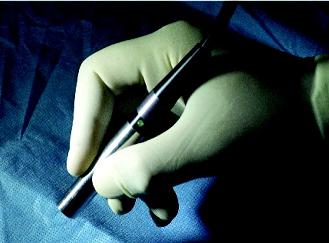
Even to experienced surgeons, the inside of your body can look like one indecipherable undulating pink mass of flesh. When removing a tumor it’s crucially important to extract all the cancerous cells, but how do you know you’ve gotten them all when many look just like healthy cells? You use a SpectroPen. Developed by researchers at Georgia Tech, Emory University, and UPenn, the SpectroPen uses infrared light and a fluorescence detector to locate special dyes and gold particles that have been injected into the body. These particles and dyes greatly prefer tumor cells, and the SpectroPen lets surgeons clearly locate cancerous tissue so they can remove it. Studies with rodents demonstrated that the SpectroPen could find tumors less than 1mm in size! The technology is already in use for surgeries with dogs, and clinical trials for humans could be starting soon. Watch out, cancer, you can’t hide from us anymore.
In the future, excising tumors may involve pumping your body full of gold. SpectroPen operates by detecting artificial agents bonded to tumor cells. These agents come in two parts: a dye that fluoresces in IR (indocynanine green), and gold nanoparticles. Those nanoparticles are coated in a polymer attached to the dye and connected to an antibody. This antibody seeks out cancerous cells (which have ‘leaky’ cell membranes). The SpectroPen shines IR light and uses a fluorescence detector to see what starts to glow. The gold nanoparticles enhance the dye’s glow so that tumors shine with 10 times the signal of healthy cells. Once the surgeon uses the SpectroPen to find cancer cells, it’s pretty easy to cut them out of the body.
That process of detection is interesting enough, but the way that doctors tested the SpectroPen is even cooler. As described in Analytical Chemistry, surgeons gave mice human breast cancer cells to grow in their bodies. The cancer cells were spliced with a firefly gene that allowed them to glow on their own! So, scientists used their dyes and nanoparticles with the SpectroPen to see what cancer they could detect. To double check their results they activated the firefly gene (with a special solution) and compared the SpectroPen results to the visibly glowing firefly-enhanced cells. The two matched up very well.
In your body, splicing cancer cells with a firefly gene would be too difficult – how would you find all the cancer cells? However, injecting the SpectroPen’s dyes and gold nanoparticles is fairly simple. The comparison test between the two show that the SpectroPen could be an accurate, but much more realistic, way of detecting cancer during surgery.
Technologies like the SpectroPen give me a lot of hope about fighting cancer. Back in February of 2009, Catherine Mohr gave an impressive talk about the future of surgery at TED. She mostly discussed how robots would increase our skill while decreasing our footprint for operations, but one of her predictions always stuck with me: the future of surgery will be about detection as much as it is about cutting. SpectroPen fits in line exactly with that sentiment. It’s not a better way of cutting, it’s a better way of knowing where to cut. That’s crucially important.
While it may be many years before SpectroPen could be available for surgery with humans, it is already moving on that path. According to Georgia Tech News, Sunil Singhal from UPenn is applying for clinical trials with human patients. James Provenzale from Duke University is working with veterinarians as they use SpectroPen for operations on dogs. The indocynanine dye was previously approved for heart and liver surgeries, and gold nanoparticles are a staple of cutting edge cancer research. There’s no obvious roadblock to developing SpectroPen for human surgeries, it’s just going to take time to prove it works consistently. There’s a good chance that in the years ahead, your doctors will be using SpectroPen, or devices very similar to it, to find and remove the tumors in your body. Inject, glow, cut – not a bad strategy for defeating cancer.
[image credit: Mohs et al 2010 Analytical Chemistry]
[sources: Georgia Tech University News, Mohs et al 2010 Analytical Chemistry]


